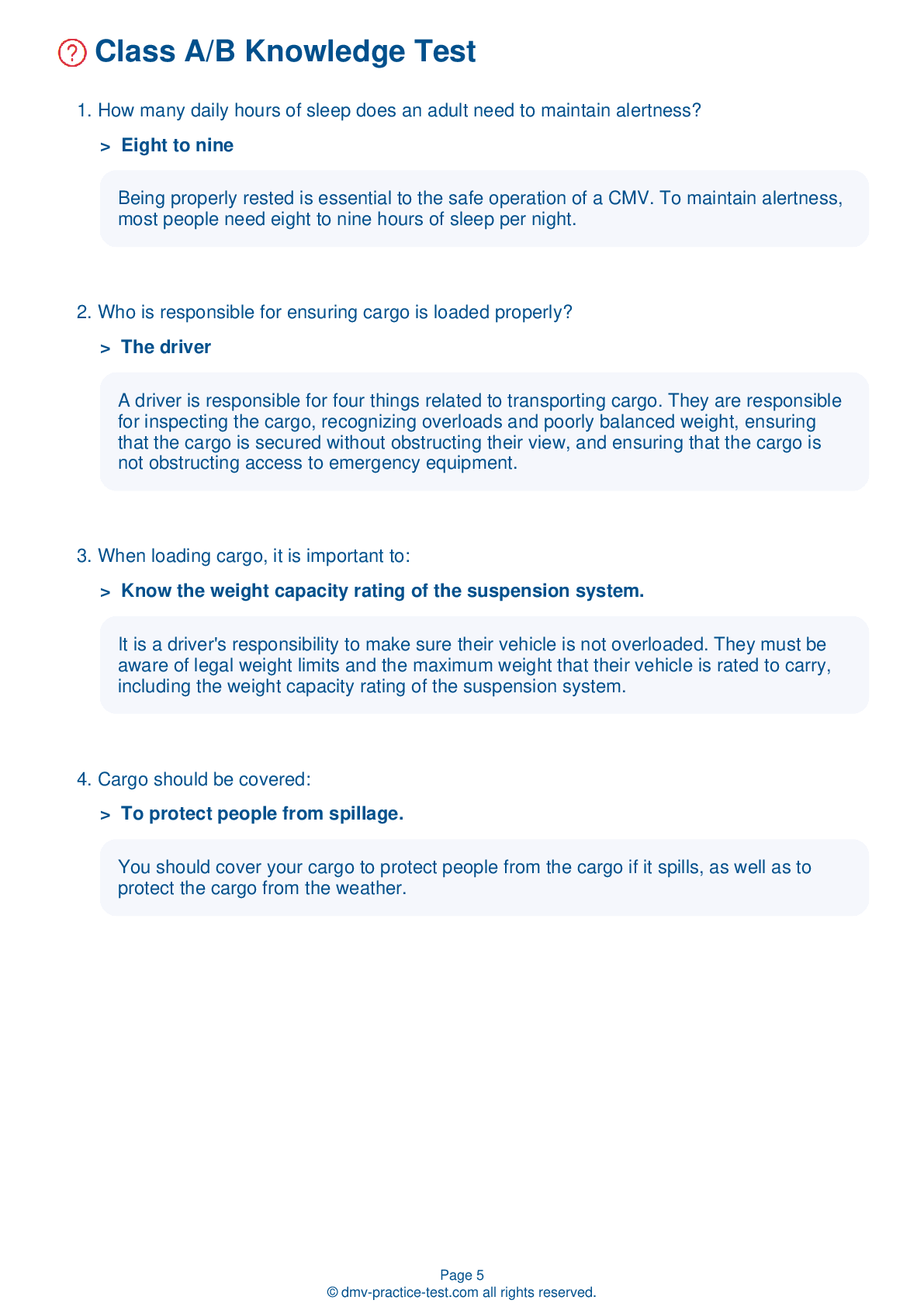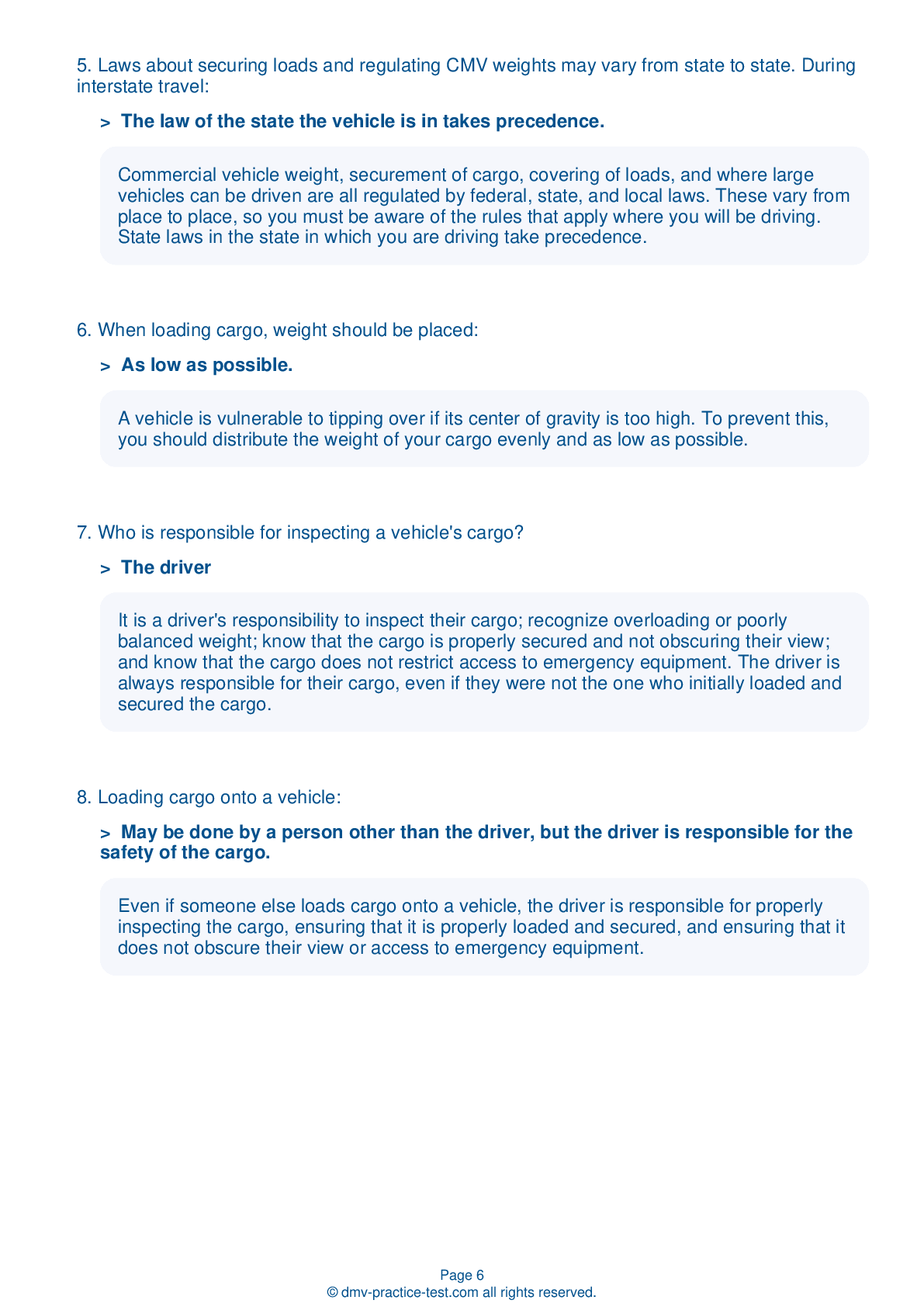Air Brakes #2
Air Brakes Endorsement Test | Connecticut 2025 #2 Page 4 of 4
Train for FREE online with our Connecticut CDL air brake test. The official exam test consists of several obligatory parts, with all of them checking your knowledge of different blocks of road rules. If you need to obtain a CT Class A/Class B driver license in 2025, practice as much as possible. Free sample tests published on our website will help you check and improve your knowledge and boost your grades. Please bear in mind that the requirements for CDL may vary from state to state.
25
20
20
19 . When an S-cam turns inside a brake drum, the S-cam:
When a brake pedal is pressed and the S-cam is turned, the S-cam presses the brake shoes against the inside of the brake drum. This causes friction and will cause the vehicle to slow.
20 . The air storage tanks:
Hold enough air for more than 1,000 braking cycles.
In an air brake system, the air storage tanks hold enough air for brakes to be used several times if the compressor stops working.
21 . A wig wag is:
Vehicles with air brakes are required to be equipped with a low pressure warning device. A wig wag is a type of low air pressure warning device. This device drops a mechanical arm into the driver's view if the pressure in the tanks drops to a level between 55 and 75 psi.
22 . Test the low pressure warning signal:
Before every trip.
It is essential that your low pressure warning light function properly. After allowing the system to charge, you can test the warning signal by rapidly applying and releasing the brake pedal. This will release air from the braking system and the warning signal should come on when pressure drops to a dangerous level.
23 . The leakage rate for a single vehicle with air brakes should be no more than ____ in one minute during a static leakage test.
When performing a static leakage test on a single vehicle with air brakes, the leakage rate should be no more than 2 psi in a minute. If the air leaks from the air brake system at a quicker rate, the vehicle should not be driven because something likely needs to be repaired.
24 . Air pressure should build up in a single air system within:
One minute.
In a vehicle with a single air brake system, after the engine is at operating rpms, the pressure in the air system should generally build from 50 to 90 psi within three minutes.
25 . When parked on a flat surface, you should:
When parking on a level surface, you should use wheel chocks. If the vehicle is not equipped with spring brakes, this is essential to prevent the trailer from moving.
Search the best driving school in your neighbourhood
2025 Connecticut | Frequently Asked Questions
A CDL Class A license in Connecticut allows the holder to operate any combination of vehicles with a Gross Combination Weight Rating (GCWR) of 26,001 pounds or more, provided the Gross Vehicle Weight Rating (GVWR) of the vehicle being towed is over 10,000 pounds. This typically includes tractor-trailers and truck and trailer combinations.
A Class A CDL license in Connecticut allows the holder to operate vehicles such as tractor-trailers, truck and trailer combinations, tank vehicles, livestock carriers, and flatbeds. The license is for any combination of vehicles with a Gross Combination Weight Rating (GCWR) over 26,001 pounds, if the towed vehicle exceeds 10,000 pounds GVWR.
To obtain a Class A CDL license in Connecticut, you must be at least 21 years old, possess a valid Connecticut driver's license, pass a vision test, and complete a commercial driver's license knowledge test. You must also pass a pre-trip vehicle inspection test and a skills test, which includes off-road maneuvers and on-road driving. Additionally, you must provide a medical examiner's certificate.
In Connecticut, you must be at least 21 years old to qualify for a Class A CDL license if you intend to drive across state lines (interstate). However, if you plan to drive only within Connecticut (intrastate), you can obtain a Class A CDL license at the age of 18.
Specific endorsements are not required for a Class A CDL license, but they can grant additional privileges. Endorsements include T for Double/Triple Trailers, P for Passenger Vehicles, N for Tank Vehicles, H for Hazardous Materials, and S for School Buses. Each endorsement requires passing a separate knowledge test and sometimes a skills test.
The Class A CDL skills test in Connecticut encompasses three main sections: a pre-trip vehicle inspection, a basic vehicle control test, and an on-road driving test. This assessment is designed to evaluate your ability to safely operate a Class A commercial vehicle, including checking for safety defects, maneuvering the vehicle in various situations, and driving in normal traffic conditions.
Yes, Class A CDL license holders may face limitations based on factors like the driver's medical condition, the type of vehicle driven, and the presence of certain endorsements. For example, drivers might be restricted to operating automatic transmission vehicles, or prohibited from driving tank or passenger vehicles without the appropriate endorsements. Also, all CDL holders must abide by federal hours-of-service regulations.
Yes, in Connecticut, the written Class A CDL test is available in multiple languages besides English. However, federal regulations require that all CDL holders understand English sufficiently to converse with the general public, understand highway traffic signs and signals, and respond to official inquiries and instructions.
Yes, you can request accommodations for the Class A CDL written test if you have a disability. The Connecticut DMV complies with the Americans with Disabilities Act (ADA) and provides reasonable accommodations like sign language interpreters, extra time, or tests in alternative formats. You should contact the DMV directly to arrange these accommodations prior to your test date.
If you fail the Class A CDL written test in Connecticut, you are allowed to retake it. However, you must wait a minimum of seven days before your next attempt. There is also a retest fee that applies each time you retake the test. It's recommended to study the CDL manual thoroughly before your next attempt.




